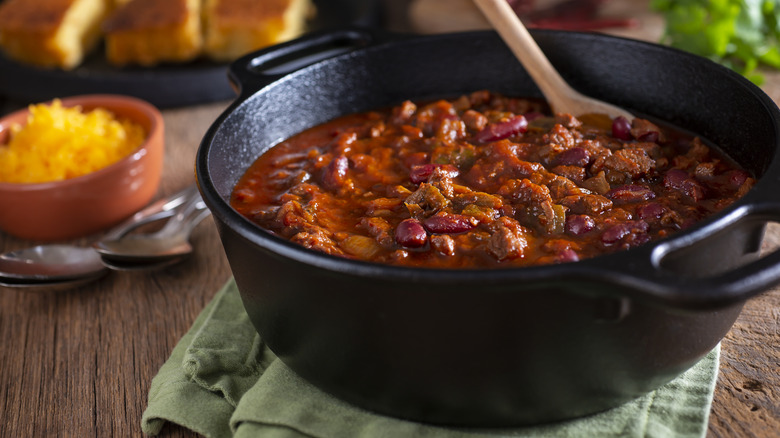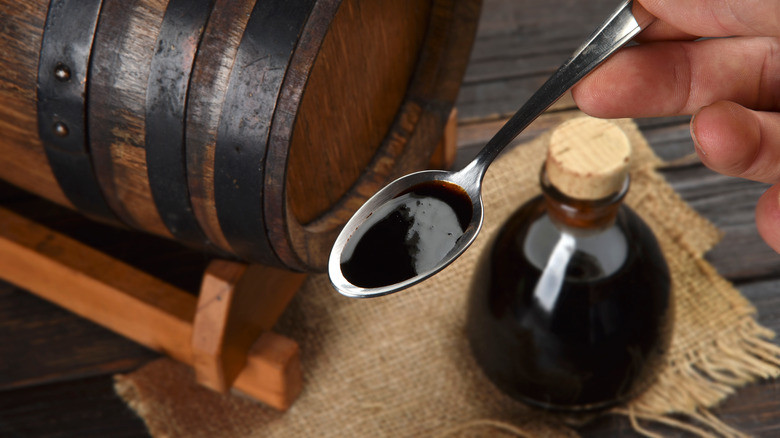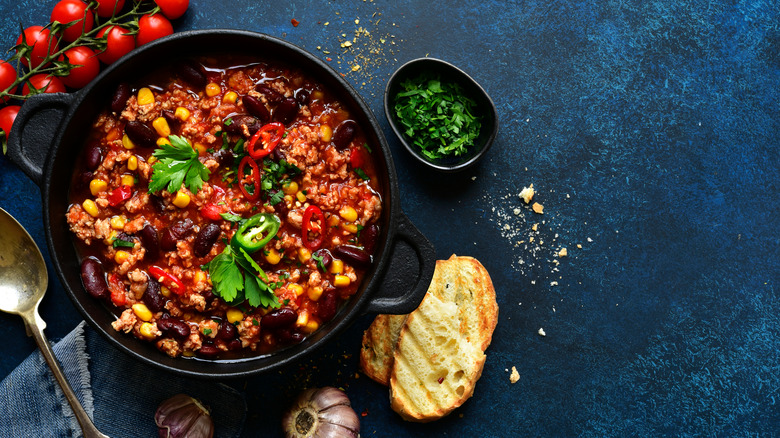Balsamic Vinegar Is The Ingredient You Need To Perk Up Chili
When the weather starts to shift and summer gives way to fall, one dish brings to mind stick-to-your-ribs comfort like no other: chili. And whether you opt for a brisket or beef, turkey or bean, or a straight-up vegetable version, there's a secret ingredient that can boost your bowl to next-level deliciousness: balsamic vinegar.
While this classic Italian ingredient — originally hailing from the Emilia-Romagna region's famous food city of Modena — may not seem like the first thought as a main ingredient for a modern American dish, there's some serious science to explain it. Acid is one of those elements in cooking that is more powerful than you may think. And with all the fat and richness of chili, vinegar can cut through and punch up, adding depth while simultaneously illuminating the layers you work so hard to develop in your chili. Balsamic is uniquely qualified from a flavor perspective.
When adding vinegar to your chili, a little goes a long way, so start slow and small and add as needed to taste. It's also important to note that vinegar will cook off, so to get the most impact, be sure to add the splash toward the end of the process. (Think about the way a chef might squeeze lemon over a dish just before it's served.)
Why balsamic, and how to purchase
In cooking, acid is what gives lift to many preparations that can otherwise be heavy on the palate. That can come in many forms, but most often, it's citrus or vinegar. Choosing your acid is a matter of taste, but some, like apple cider, white wine, or champagne, wouldn't have the backbone to stand up to the super savory elements of chili.
Balsamic, on the other hand, is a robust vinegar. It's made from fermented grapes, and the barrel-aging process allows it to deepen and become more viscous, giving it real substance and presence. And while it's a delicious finishing vinegar, the right balsamic has great cooking qualities, too. Tasting notes range from molasses and dark fruit to chocolate and even a slight smokiness in some cases, all of which pair with and balance out the moody brown sugar and caramelized flavors going on in chili.
When purchasing balsamic, you'll encounter a range of prices and qualities, and because the true balsamic of Modena is protected by the Italian government, authenticity is often in question. Picking up a high-quality bottle (typically labeled Aceto Balsamico Tradizionale di Modena) can be a worthy investment. But for cooking purposes, you can go with the more budget-friendly "Balsamico di Modena IGP." A sure way to spot the real deal is to glance at the ingredient list. The first one should be "cooked grape must;" if another vinegar is listed first, you have an imposter on your hands.
Other additions to turn you into a chili champion
One of the wonderful things about chili is the adaptability of the dish. From the ingredients you choose to the cooking method, you can probably make chili every day and never tire of this American staple dish and its many riffs.
The spice profile of your chili is a huge component of its personality. Making a few simple swaps can entirely spin your finished product. Try paprika, cumin, coriander, or fennel seed. You can opt to add coffee, beer, or even dark chocolate for depth. Whether you go con carne or veggie-forward, crunch-ify your chili by topping it with crumbled tortilla chips or breadcrumbs, fried onions, and even crushed graham crackers.
Choose a different cheese, like chevre or feta, or sprinkle a few fresh herbs over the top for an aromatic element. Consider how sweet, bright flavors might bring nuance to your chili, too. Dried fruit like raisins or figs are perfect little pops that do well in a cooked dish.
Chili often has a Tex-Mex flair, but try an Italian inflection with Chicken Parm Chili, or go for Thanksgiving vibes with Turkey Pumpkin Chili. Chili is an ideal main dish, but it's super fun as a topping, too. Ladle onto baked potatoes, or even try Chili Pizza for the comfort food supergroup of your dreams.


